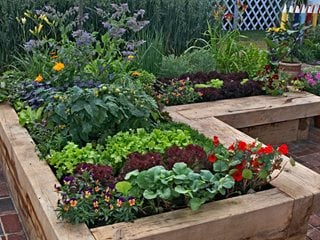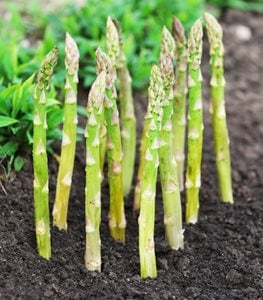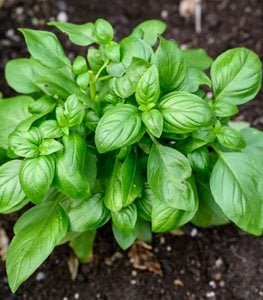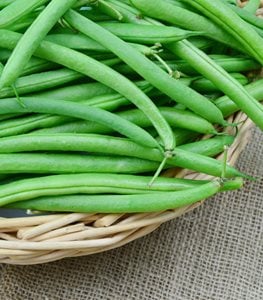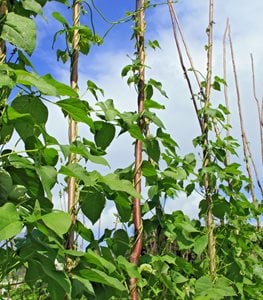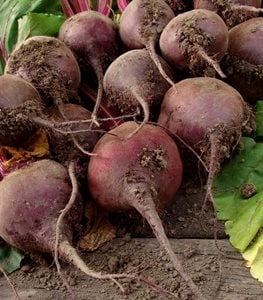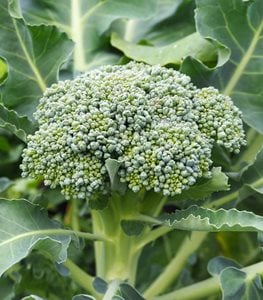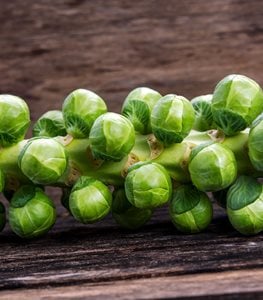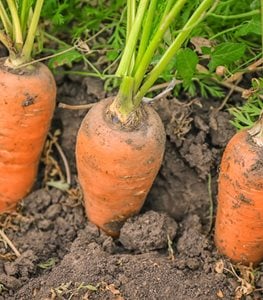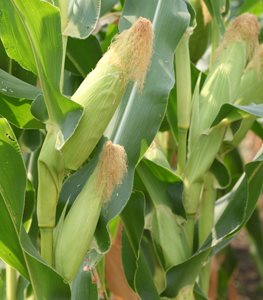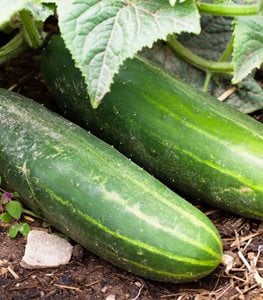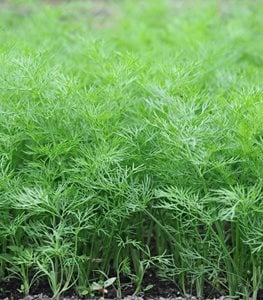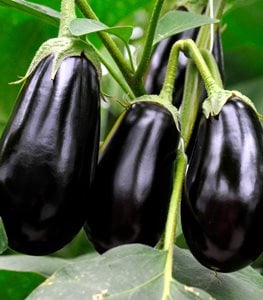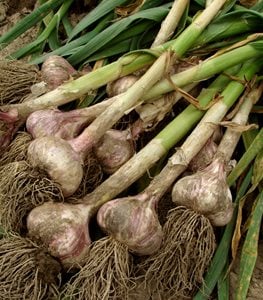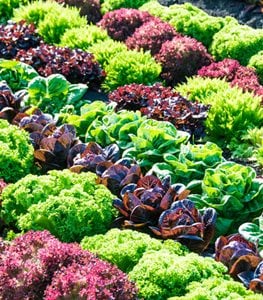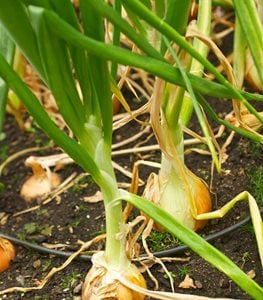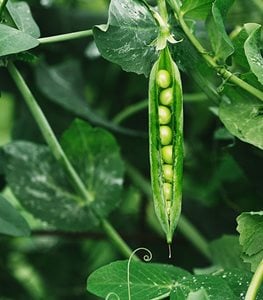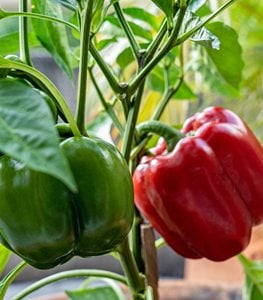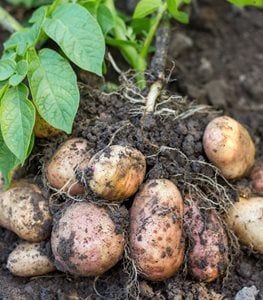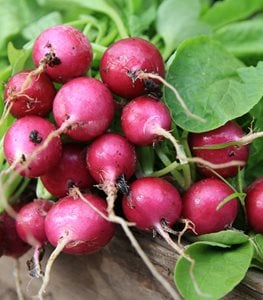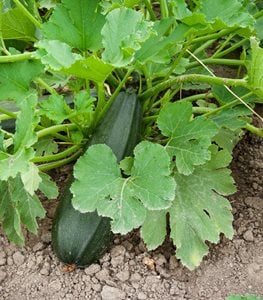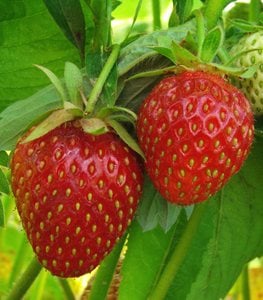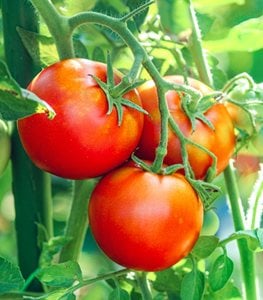Companion Planting for Vegetables & Herbs
Enjoy the benefits on companion planting, help your plants help each other.Many factors help plants to grow, including light, soil, water, and nutrients. What many gardeners overlook are the beneficial relationships that exist between plants, a growing method known as companion planting.
For example, one plant may deter garden pests that harm another species, while in return, that other species might enhance soil nutrients. Vegetables in particular see better yields, flavor, and pest and disease resistance when sited next to good neighbors. Conversely, certain combinations can result in poor performance.
Companion planting isn’t an exact science. Some combinations work better than others; factors such as weather and regional differences can impact effectiveness. Understanding how plants, insects, and organisms work together can reduce or eliminate the need for inorganic remedies, increase your gardening successes, and influence your plant choices.
Here are some key vegetables and herbs to consider, along with their beneficial helpers and plants to avoid. These are general recommendations; results may vary.
VEGETABLE GARDEN COMPANION PLANTS
ASPARAGUS
Companions: Basil, coriander, dill, marigold, parsley, tomato
Basil, marigold, parsley, and tomato protect against asparagus beetle. Coriander and dill repel pests such as aphids and spider mites.
Keep away from: Garlic, onion, potato
BASIL
Companions: Asparagus, beet, borage, carrot, chamomile, chives, marigold, oregano, pepper, radish, tomato, turnip
Borage improves the growth and flavor of basil. Flowering herbs such as chamomile, chives, and oregano enhance essential oil content in basil. When planted together, basil and marigold are a potent natural pest repellant.
Keep away from: Cucumber, fennel, rue, sage
Benefits of growing basil: Basil repels aphids, asparagus beetle, mosquitoes, and tomato hornworm. It also boosts tomato yields, while the flowers attract insect pollinators.
Learn more about growing basil.
BEANS (BUSH)
Companions: Beet, broccoli, Brussels sprouts, cabbage, carrot, catnip, cauliflower, celery, corn, cucumber, eggplant, kale, marigold, nasturtium, peas, potato, radish, rosemary, squash, strawberry, tomato
Catnip repels flea beetle, a common vegetable pest. Marigold and potato deter Mexican bean beetle. Nasturtium and rosemary repel bean beetle.
Keep away from: Allium relatives such as chives, garlic, onion, and shallots can stunt the growth of legumes such as beans.
Benefits of growing beans: Beans provide nitrogen to the soil.
Learn more about growing beans.
BEANS (POLE)
Companions: Broccoli, cabbage, carrot, catnip, cauliflower, celery, corn, cucumber, eggplant, marigold, nasturtium, peas, potato, radish, rosemary, squash, strawberry, tomato
Corn acts as a natural trellis while providing shade. Squash shades the roots and repels pests.
Keep away from: Pole beans can experience stunted growth when planted near beets, but bush beans are unaffected. Vegetables in the allium family such as chives, garlic, onion, and shallots can also stunt pole bean growth.
Benefits of growing beans: Beans provide nitrogen to the soil.
BEETS
Companions: Beans, broccoli, Brussels sprouts, cabbage, cauliflower, garlic, kohlrabi, leeks, lettuce, onion
Garlic improves growth and flavor of beets.
Keep away from: Pole beans and beets stunt each other’s growth.
Benefits of growing beets: Composted beet leaves add magnesium to the soil.
BROCCOLI
Companions: Basil, beet, celery, cucumber, dill, garlic, lettuce, marigold, mint, nasturtium, onion, potato, radish, rosemary, spinach, thyme
Dill attracts predatory wasps that control pests. Rosemary repels cabbage fly. Celery, potato, and onion improve the flavor of broccoli.
Keep away from: Asparagus, beans (pole), corn, melons, pepper, pumpkin, squash, strawberry
BRUSSELS SPROUTS
Companions: Basil, beans, beet, carrot, garlic, mint, nasturtium, onion, peas, thyme
Brussels sprouts are susceptible to a number of insect pests, including aphids, beetles, cabbage looper, cutworm, leafminer, and squash bug. Pungent companions such as basil, garlic, onion, and mint can repel these pests.
Keep away from: Beans (pole), strawberry, tomato. Strawberries can inhibit growth of Brussels sprouts.
CABBAGE
Companions: Beans (bush), beet, celery, chamomile, dill, mint, onion, oregano, rosemary, sage, thyme
Marigolds and aromatic herbs such as mint, rosemary, and thyme repel cabbage moth. Dill, celery, garlic, mint, and onion enhance the taste of cabbage.
Keep away from: Beans (pole), mustard, strawberry, tomato.
CARROTS
Companions: Beans, chives, lettuce, onion, pea, pepper, radish, rosemary, sage, tomato
Beans fix nitrogen into the soil. Chives improve growth and flavor. Onion, parsley, rosemary, and sage deter carrot fly.
Keep away from: Dill, parsnip. Dill may stunt the growth of carrots.
CORN
Companions: Beans, cucumber, marigold, melon, parsley, peas, potato, pumpkin, squash, sunflower
Corn is a heavy feeder; beans and peas add nitrogen to the soil. Marigolds repel Japanese beetles.
Keep away from: Celery, tomato. Tomato attracts pests that also attack corn, including tomato hornworm and corn earworm.
Benefits of growing corn: Corn provides shade and is a natural trellis for pole beans.
CUCUMBER
Companions: Beans, cabbage, cauliflower, corn, dill, lettuce, marigold, nasturtium, peas, radish
Dill attracts beneficial insects that feed on pests such as cucumber beetle. Nasturtium deters aphids and beetles while improving growth and flavor. Radish repels pests including cucumber beetle and rust fly.
Keep away from: Aromatic herbs (except dill), potato, tomato. Cucumbers grow poorly when planted near potatoes or sage.
DILL
Companions: Broccoli, Brussels sprouts, cabbage, corn, cucumber, lettuce, onion
Keep away from: Cilantro, carrot, tomato. Dill cross-pollinates with cilantro and carrot.
Benefits of growing dill: Dill discourages pests including aphids, cabbage loopers, and spider mites. It also attracts beneficial insects such as bees, hoverflies, ladybugs, and parasitic wasps.
EGGPLANT
Companions: Beans, catnip, marigold, peas, pepper
Catnip repels flea beetles, a common vegetable pest. Eggplant is a heavy feeder; beans and peas fix nitrogen into the soil. Marigold deters nematodes.
Keep away from: Other solanum relatives such as pepper, potatoes, tomatoes make eggplant more susceptible to blight.
GARLIC
Companions: Beet, broccoli, cabbage, carrot, cauliflower, dill, eggplant, kohlrabi, pepper, potato, spinach, tomato
Chamomile improves garlic flavor. Rue repels maggots. Summer savory and yarrow also benefit garlic.
Keep away from: Garlic can stunt the growth of asparagus, beans, parsley, peas, and sage.
Benefits of growing garlic: Garlic keeps away a wide range of pests, including ants, aphids, cabbage looper, fungus gnat, Japanese beetle, onion fly, snails, and spider mites.
KALE
Companions: Beet, beans, celery, cucumber, dill, garlic, lettuce, mint, onion, peas, pepper, potato, rosemary, sage, spinach
Kale is a heavy nitrogen feeder. Plant near beans or peas, which add nitrogen to the soil.
Keep away from: Avoid planting kale near other brassicas such as broccoli, Brussels sprouts and cauliflower to prevent spread of disease.
LETTUCE
Companions: Asparagus, basil, beans, beet, broccoli, Brussels sprouts, carrot, chives, corn, cucumber, eggplant, garlic, mint, onion, peas, radish, spinach, strawberry, tomato
Basil improves lettuce flavor while repelling mosquitoes. Beets supply minerals to the soil that lettuce needs to thrive. Chives and garlic deter aphids. Mint repels cabbage moths and slugs, which are lettuce pests.
Keep away from: Some sources say to avoid planting lettuce near brassicas such as broccoli and cabbage, while others say it’s fine. Results may vary. Cabbage, celery, and parsley may inhibit lettuce growth.
MINT
Companions: Beet, broccoli, Brussels sprouts, cabbage, cauliflower, eggplant, kale, kohlrabi, lettuce, peas, squash
Keep away from: Chamomile, parsley
Benefits of growing mint: Mint is a natural pest deterrent. It repels flea beetle, which chews holes in the leaves of cabbage, cauliflower, kale, and radish. It also discourages aphids, carrot root fly, mealy bugs, onion fly, and spider mites. Mint attracts beneficial insects such as hoverflies, ladybugs, and predatory wasps that feed on pests.
ONION
Companions: Beet, broccoli, Brussels sprouts, cabbage, carrot, chamomile, lettuce, pepper, strawberry, tomato
Keep away from: Asparagus, beans, peas, sage. Don’t plant near other alliums such as garlic, leek, and shallots to avoid spreading onion maggots or rust.
Benefits of growing onions: Onion repels brassica pests including cabbage loopers, cabbage worms, and cabbage maggots. It also deters aphids, carrot fly, and Japanese beetle.
PEAS
Companions: Beans, carrot, celery, corn, cucumber, eggplant, lettuce, potato, radish, spinach, tomato, turnip
Keep away from: Allium relatives such as chives, garlic, onion, and shallots can stunt the growth of peas.
Benefits of growing peas: Peas are good companions to many other vegetables because they increase the availability of nitrogen in the soil.
PEPPERS
Companions: Basil, beans, beet, carrot, chives, coriander, cucumber, dill, eggplant, garlic, lettuce, parsley, onion, spinach, tomato
Basil deters aphids, spider mites, and thrips, and improves the flavor of peppers. Dill and coriander repel aphids and encourage beneficial insects. Parsley attracts predatory wasps that feed on aphids. Alliums such as chives, garlic, and onion repel aphids, beetles, slugs, and spider mites.
Keep away from: Brassicas including broccoli, Brussels sprouts, cabbage, and cauliflower.
Learn more about how to grow peppers.
POTATOES
Companions: Basil, beans, cabbage, chamomile, corn, horseradish, lettuce, marigold, parsley, peas, radish, spinach, thyme
Beans repel Colorado potato beetle. Horseradish increases disease resistance. Many herbs such as basil, chamomile, parsley, and thyme enhance potato flavor while attracting beneficial insects.
Keep away from: Cucumber, raspberry, and tomato attract harmful insects. Avoid planting near other vegetables in the nightshade family such as eggplant, pepper, and tomato to keep from spreading soil pathogens. Asparagus, carrot, fennel, onion, and turnip can stunt the growth of potatoes.
Learn more about growing potatoes.
RADISH
Companions: Beans, carrot, chervil, cucumber, lettuce, melon, nasturtium, peas, spinach, squash
Chervil deters aphids and slugs which are radish pests. Chervil and nasturtium improve growth and flavor of radishes.
Keep away from: Brassicas such as broccoli, Brussels sprouts, cabbage, and cauliflower. Hyssop stunts the growth of radish.
Benefits of growing radishes: Radish can be used as a “trap plant” to lure pests such as root maggots and flea beetles away from other vegetables. It also repels cucumber beetle and squash bugs.
ROSEMARY
Companions: Beans, broccoli, Brussels sprouts, cabbage, carrot, cauliflower, kale
Keep away from: Pumpkins, squash
Benefits of growing rosemary: The pungent scent of rosemary repels many pests including bean beetle, cabbage looper, cabbage moth, carrot root fly, slugs, snails, and weevils. The flowers of rosemary attract insect pollinators. Rosemary improves the flavor of sage when planted together.
SQUASH / ZUCCHINI
Companions: Beans, borage, corn, marigold, nasturtium, peas, radish, tansy
Borage attracts insect pollinators and improves growth and flavor. Nasturtium deters aphids and squash bugs and improves growth and flavor. Radish and tansy repel squash bugs.
Keep away from: Potato, pumpkin. Potato is a heavy feeder, competing for nutrients. Pumpkin, which is closely related to squash, can cross-pollinate, affecting seed saved for the next year’s crop.
STRAWBERRY
Companions: Beans, borage, caraway, chives, garlic, lettuce, onion, sage, spinach, thyme
Alliums such as garlic and chives repel predatory insects. Borage attracts pollinators and repels strawberry pests while increasing disease resistance. Caraway attracts beneficial insects such as wasps that kill strawberry pests. Planting lettuce, spinach, and strawberry together can enhance productivity.
Keep away from: Plants that are susceptible to verticillium wilt such as eggplant, pepper, potato, and tomato should not be planted nearby. Strawberry can inhibit the growth of brassicas such as broccoli and cauliflower.
Learn more about how to grow strawberries.
TOMATO
Companions: Asparagus, basil, borage, carrot, celery, chives, cucumber, garlic, lettuce, marigold, mint, onion, parsley
Asparagus repels nematodes that attack tomato plants. Basil improves tomato growth and deters pests such as flies and tomato hornworm. Borage improves growth and flavor and repels tomato hornworm.
Keep away from: Don’t plant near dill or brassicas such as broccoli, Brussels sprouts, cabbage, and cauliflower, as they can stunt tomato growth. Keep away from corn, which attracts tomato hornworm.
Benefits of growing tomatoes: Plant tomatoes near asparagus to repel asparagus beetle.
Learn more about how to grow tomatoes and tomato companion plants.
BENEFITS OF COMPANION PLANTING
The many benefits of companion planting include:
- Plants that repel pests on other plants reduce the need for other forms of pest control.
- Root vegetables such as carrots break up soils, lessening soil compaction and increasing aeration.
- Plants that support each other reduce the need for staking and trellising.
- Peas and other legumes fix nitrogen into the soil, nourishing other plants.
- Plants with a large canopy such as pumpkins and squash can reduce weeds, shade other nearby plants and reduce water usage.
- Vegetables have higher yields and better flavor when sited next to compatible plants.
- Companion planting maximizes the use of your garden space.
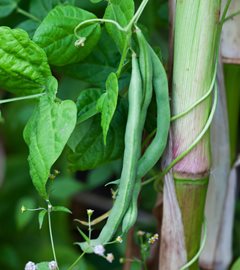
Photo: Besjunior / Shutterstock.
HISTORY OF COMPANION PLANTING:
THE THREE SISTERS
The concept of companion planting goes back hundreds of years. Indigenous Peoples planted corn, beans, and squash together, a symbiotic combination known as the Three Sisters.
Corn provides a natural trellis for climbing beans, while bean vines anchor the corn stalks, making them less prone to being blown over. Beans attract beneficial insects while boosting nitrogen levels in the soil, helping corn and squash to grow. The large leaves of squash suppress weeds and provide shade to cool the soil, slowing water evaporation. Tiny spines along the stems and leaves of squash deter predators and insect pests.
At the end of the growing season, the spent plants are worked back into the soil to provide nutrients for the following year.
RELATED:
16 Spring Vegetables
15 Fall Vegetables
Raised Bed Garden Design
